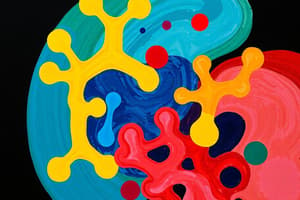Podcast
Questions and Answers
What is the main component of proteoglycans?
What is the main component of proteoglycans?
- Protein
- Lipid
- Carbohydrate (correct)
- Nucleic Acid
What is the function of GAGs in the body?
What is the function of GAGs in the body?
- To transport oxygen
- To provide structural support
- To bind large amounts of water (correct)
- To store energy
What is the difference between proteoglycans and glycoproteins?
What is the difference between proteoglycans and glycoproteins?
- Proteoglycans are found in the cytoplasm, glycoproteins are found in the ER
- Proteoglycans have more protein, glycoproteins have more carbohydrate
- Proteoglycans are found in the nucleus, glycoproteins are found in the mitochondria
- Proteoglycans have more carbohydrate, glycoproteins have more protein (correct)
What is the role of fibrous structural proteins in the ECM?
What is the role of fibrous structural proteins in the ECM?
What is the extracellular matrix (ECM) composed of?
What is the extracellular matrix (ECM) composed of?
What is the main difference between glycosaminoglycans and proteoglycans?
What is the main difference between glycosaminoglycans and proteoglycans?
What is the role of glycosaminoglycans in the ECM?
What is the role of glycosaminoglycans in the ECM?
What is the composition of a proteoglycan?
What is the composition of a proteoglycan?
What is the role of hydrated GAGs in the ECM?
What is the role of hydrated GAGs in the ECM?
What is the main component of proteoglycans?
What is the main component of proteoglycans?
How do proteoglycan monomers associate with hyaluronic acid?
How do proteoglycan monomers associate with hyaluronic acid?
What is the general structure of GAGs?
What is the general structure of GAGs?
What is unique about keratan sulfate?
What is unique about keratan sulfate?
What is the primary function of link proteins?
What is the primary function of link proteins?
What is the main difference between proteoglycans and glycoproteins?
What is the main difference between proteoglycans and glycoproteins?
What is the term for the repeating unit of GAGs?
What is the term for the repeating unit of GAGs?
What is the usual form of the amino group in glycosaminoglycans?
What is the usual form of the amino group in glycosaminoglycans?
What is the function of the sulfate groups in glycosaminoglycans?
What is the function of the sulfate groups in glycosaminoglycans?
What is the result of the negative charge of glycosaminoglycans in solution?
What is the result of the negative charge of glycosaminoglycans in solution?
What is the effect of compressing a solution of glycosaminoglycans?
What is the effect of compressing a solution of glycosaminoglycans?
What is the characteristic of mucous secretions and synovial fluid due to the presence of glycosaminoglycans?
What is the characteristic of mucous secretions and synovial fluid due to the presence of glycosaminoglycans?
What is the epimer of D-glucuronic acid?
What is the epimer of D-glucuronic acid?
What is the main component of a proteoglycan monomer found in cartilage?
What is the main component of a proteoglycan monomer found in cartilage?
What is the type of bond that can occur on carbon 4 or 6 in glycosaminoglycans?
What is the type of bond that can occur on carbon 4 or 6 in glycosaminoglycans?
How many disaccharide units are found in each GAG chain?
How many disaccharide units are found in each GAG chain?
What is the type of sugar that can be found in glycosaminoglycans?
What is the type of sugar that can be found in glycosaminoglycans?
What is the type of bond formed between the xylose and the hydroxyl group of the serine?
What is the type of bond formed between the xylose and the hydroxyl group of the serine?
How are proteoglycan monomers associated with hyaluronic acid?
How are proteoglycan monomers associated with hyaluronic acid?
What is the structure of proteoglycan monomers resembles?
What is the structure of proteoglycan monomers resembles?
What is the linkage between the carbohydrate chain and the protein?
What is the linkage between the carbohydrate chain and the protein?
What is the name of the integral membrane proteoglycan?
What is the name of the integral membrane proteoglycan?
What is the type of proteoglycans found primarily in the nervous system?
What is the type of proteoglycans found primarily in the nervous system?
What is the order of removal of groups during lysosomal degradation of GAGs?
What is the order of removal of groups during lysosomal degradation of GAGs?
What is the consequence of deficiencies in lysosomal enzymes involved in GAG degradation?
What is the consequence of deficiencies in lysosomal enzymes involved in GAG degradation?
What is the prevalence of mucopolysaccharidoses?
What is the prevalence of mucopolysaccharidoses?
What is the characteristic of mucopolysaccharidoses?
What is the characteristic of mucopolysaccharidoses?
What is the result of incomplete lysosomal degradation of GAGs?
What is the result of incomplete lysosomal degradation of GAGs?
What is the cause of mucopolysaccharidoses?
What is the cause of mucopolysaccharidoses?
What is the effect of mucopolysaccharidoses on the body?
What is the effect of mucopolysaccharidoses on the body?
What is the characteristic of progressive diseases?
What is the characteristic of progressive diseases?
Study Notes
Overview of Glycosaminoglycans
- Glycosaminoglycans (GAGs) are large, negatively charged heteropolysaccharide chains associated with a small amount of protein ("core protein") to form proteoglycans.
- Proteoglycans typically consist of up to 95% carbohydrate and 5% core protein.
- GAGs have the ability to bind large amounts of water, producing a gel-like matrix that forms the basis of the body's ground substance.
- The hydrated GAGs serve as a flexible support for the extracellular matrix (ECM), interacting with structural and adhesive proteins.
Structure of Glycosaminoglycans
- Proteoglycans are found in the ECM and on the outer surface of cells.
- GAGs are associated with a small amount of protein ("core protein") by an O-glycosidic bond, forming proteoglycans.
- Proteoglycans contain a greater amount of carbohydrate than do glycoproteins, which consist primarily of protein with a variable amount of carbohydrate.
- GAGs are long, unbranched heteropolysaccharide chains composed of a repeating disaccharide unit ([acidic sugar–amino sugar]n).
- Keratan sulfate is an exception, containing galactose instead of an acidic sugar.
- The amino sugar is either D-glucosamine or D-galactosamine, which may be acetylated, sulfated, or non-acetylated.
- The acidic sugar is either D-glucuronic acid or L-iduronic acid (C-5 epimer of D-glucuronic acid).
Relationship between Glycosaminoglycan Structure and Function
- Being negatively charged, GAG chains are extended in solution and repel each other, producing the "slippery" consistency of mucous secretions and synovial fluid.
- When a solution of GAGs is compressed, the water is "squeezed out" and the GAGs are forced to occupy a smaller volume.
Structure of Proteoglycan Monomers
- A proteoglycan monomer found in cartilage consists of a core protein and up to 100 linear chains of GAGs covalently attached to the core protein.
- Each GAG chain contains up to 200 disaccharide units.
- The resulting structure resembles a "bottle brush".
Degradation of Glycosaminoglycans
- Lysosomal degradation of GAGs involves the removal of the last group added during synthesis, followed by the action of sulfatases or exoglycosidases.
- Endo- and exoglycosidases are also involved in the lysosomal degradation of glycoproteins and glycolipids.
- Deficiencies in these enzymes result in the accumulation of partially degraded carbohydrates, leading to tissue damage.
Mucopolysaccharidoses
- Mucopolysaccharidoses are hereditary diseases characterized by the accumulation of glycosaminoglycans in various tissues, causing progressive symptoms such as skeletal and extracellular matrix deformities, and mental retardation.
- These diseases are caused by a deficiency of any one of the lysosomal hydrolases normally involved in the degradation of heparan sulfate and/or dermatan sulfate.
- This results in the presence of oligosaccharides in the urine, due to incomplete lysosomal degradation of glycosaminoglycans.
Studying That Suits You
Use AI to generate personalized quizzes and flashcards to suit your learning preferences.
Description
This quiz covers the basics of glycosaminoglycans, proteoglycans, and glycoproteins. It is part of a biochemistry course, specifically chapter 14. Topics include the structure and function of glycosaminoglycans.




